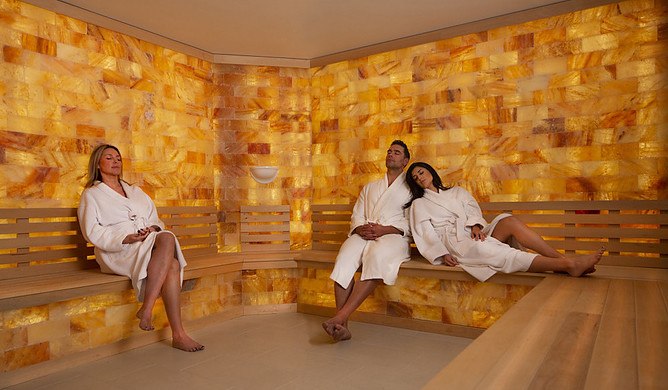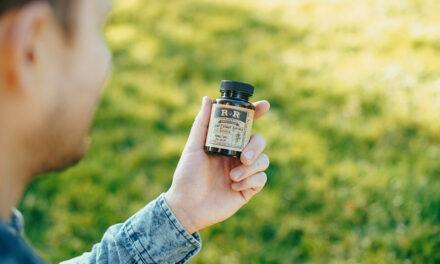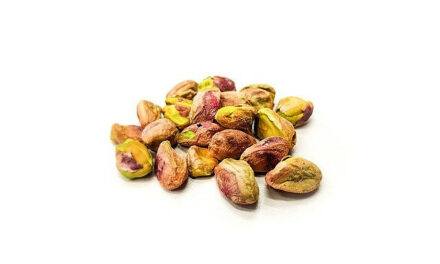Himalayan salt continues to gain popularity for its beautiful colors, hues and creative application. Salt walls made from Himalayan salt bricks were being used to design and build salt rooms and caves for Speleotherapy, soon enough, Salt therapy began to trend amongst wellness centers and Spas. Eventually Himalayan salt bricks, tiles and walls application expanded to other uses such as flooring and wall treatment for different environments and spaces. But, Are Himalayan Salt Brick Walls, Caves and Spas Healthy?
Himalayan salt is famed not just for its charming hues, but the health benefits it is said to provide. It is claimed to emit negative ions when the heat is applied to it and thus by breathing it in, you get the same soothing and relaxing sensation as when you’re at the beach. Plus it is natural and unprocessed salt, which means all of its mineral contents are intact.
What possible risks could come from using this wonderful salt? We will shortly discuss these effects in detail to confirm if Himalayan Salt Brick Walls, Caves and Spas Healthy for diabetes, high blood pressure, and stress and anxiety disorders.
Let’s start rolling…
Dry Salt Therapy
Speleotherapy and Halotherapy are both types of Dry Salt Therapy.
Even though they are less common in some areas, Speleotherapy occurs in natural underground caves containing salt. Halotherapy, on the other hand, creates the same effect in an artificial environment. Wellness centers and places that offer Halotherapy, spread tiny salt particles around the room using dry salt aerosol.
Active Salt rooms use a generator (halo generator) to spread the tiny salt particles around the room.
Passive Salt rooms contain large amounts of salt in the room, and no generator to spread it around. The STA (Salt Therapy Association) suggests that Passive Salt rooms can be relaxing and improve an individual’s well-being, but they are not a form of halotherapy.
What is a Himalayan Salt Brick?
Made of pink salt, a type of salt crystal mined exclusively from the Himalayan mountains in Pakistan, Himalayan Salt Brick is used in the construction, designing, and creation of relaxing and soothing environments.
Himalayan Salt Brick comes in various sizes ranging from 4 X 4 inch brick to about 10 X 16 inch brick, they are either smooth or have rough-cut finishes, and can be found in pink color variations such as light pink, red, amber or rare Himalayan white.
The Salt Bricks can be used in the construction of salt caves and salt rooms (for Spa, yoga rooms and gyms), building room separation, floor tiling, walls in front of a radiator, small sections of walls and many other things.
A Brick unit may also be placed on a clay stove, heater or radiator during the heating season, or in front of a lamp, wick or any source of light, to heat up the Salt Brick and provide both color and ionizing therapy effects.
Tip: Have you heard about Himalayan Salt Inhalers? We have covered it too.
What is a Himalayan Salt Tile?
Himalayan Salt Tile is also made of Himalayan pink salt, but unlike the Salt Brick, which is either square or rectangular in shape, the Himalayan salt tile is carved in a variety of polygonal shapes and sizes.
Salt tiles may be crafted as
- 4 sides equal rectangle,
- 4 sides equal square,
- 3 sides equal triangle,
- 5 sides equal pentagon, and
- 6 sides equal hexagon, or
- custom shaped per demand.
These Himalayan salt tiles can be used for construction purposes, flooring, and decoration.
The Benefits of Himalayan Salt Walls
There’s something about spending time at the beach and breathing fresh ocean air that is relaxing and it is just different. Of course, that is because the oxygen is naturally purified by the salt in the air, which in turn makes the people who breathe it in feel more relaxed.
In the same way, the introduction of Himalayan salt air therapy into your regular wellness routine comes with a plethora of benefits. Just by having a Himalayan salt wall in any of the rooms in your home gives it a distinctive ambiance and feel with a great negative ion output.
We will discuss more on negative ions and their health benefits later, but here are some benefits of having a Himalayan salt wall:
-
Interior decoration
The translucent appearance of the Himalayan salt wall adds an impressive look to your space.
-
Improvement in lung function
There’s a positive influence and possible improvement in the treatment of respiratory illnesses such as asthma, COPD and various other respiratory conditions.
-
Works on the nervous system
Improves the ability to concentrate, slows down breathing, reduces stress, and improves sleep.
-
Minerals
It contains about 84 trace minerals beneficial to your body such as magnesium, potassium, iodine, sodium, bromine, iron and other trace minerals.
-
Mood boost
It can clear impurities in the air, while giving off a calming light.
-
Dermatological benefits
It works on certain skin conditions, including psoriasis, acne, and dermatitis.
- Emits negative ions which balance the many positive ions we encounter daily.
- Helps in regulating blood pressure, pH acid levels, and high blood sugar.
Decorating with Himalayan Salt Walls
The captivating lighting capabilities, earthly nostalgic effects, and infinite custom décor possibilities of Himalayan salt walls, adds functional beauty and uniqueness to any indoor living space.
As the popularity of Himalayan salt and it’s health benefits is spread globally, the use of Himalayan salt blocks, tiles and walls as décor elements have also
grown popular.
Initially, Himalayan salt walls with subtle lighting techniques were mostly utilized by businesses around the globe to create a healthy and tranquil atmosphere for their customers and clients.
Prominent Hotels have used the salt to create fascinating walls in saunas, as well as yoga and spa rooms. But in recent times, Himalayan salt walls are now being featured globally in the trendiest lobbies, restaurants and lounges.
Himalayan salt blocks and walls as a simple addition for businesses and homes, turns any space into a relaxing respite from day to day stress. And not just that, it adds artful beauty and style to the décor scheme.

Why Himalayan Salt?
There are many other salts out there, each unique in taste, texture and convenience; so what makes Himalayan salt distinguished from the rest.
One unique attribute is the presence of iron oxide, which makes the color appear in various shades of pink. The enchanting and pleasing appearance of its pink shades, is said to have Chromotherapy effects mostly used for the seasonal effective disorder (SAD) treatment and relaxation.
Himalayan salt is generally pink, with tints of white and red. The color variation starts from
- White,
- Light pink,
- Amber pink,
- Rose pink,
- Reddish dark pink,
- meat red and
- Greyish Red.
The darker shades contain more iron, it is not really recommended for eating to avoid having too much iron in the body system. But that doesn’t stop the majority of people who prefer to cook with Himalayan salt, as well as saunas, spa, gyms and businesses who use it to create relaxing and healing environments.

Tip: Love a spa? Here’s what we through about Sharper Image Leg Spa for home use.
What are Negative Ions?
Molecules in the atmosphere are charged with electricity, the negatively charged oxygen molecules around us are negative ions. These negative ions allow us to take in just a little bit more oxygen, around 20% more. Negative ions which are also known as “vitamins of the air”, are said to fight against toxic effects of positive ions (or electronic smog) existing in our environment due to electronic devices.
An abundance of negative ions exists in nature. They can be found in:
- UV (ultraviolet) rays emitted by the sun
- Electric discharges in the air after a lightning strike or thunderclap
- Water collisions like ocean shores or waterfall
- Plants
Researchers claim the positive effects from exposure to negative ions, is as a result of chemical reactions between the negative ions and our DNA and bodily tissues.
Benefits of Negative Ions
- Fights against the harmful effects of positive ions in the environment.
- Prevents symptoms of respiratory disorders.
- Improves mood and sleep patterns.
- Prevents allergies.
- Boosts metabolism of carbs and fat.
- Reduces symptoms of depression and SAD (seasonal effective disorders) for some people.
- Improves breathing difficulties.
- Increases immune system function.
- Promotes antibacterial activity.
Risks of Negative Ions
The risks associated with negative ions come from ion generators or negative ionizers installed in closed small spaces. These ionizers discharge electric currents into the air which generate negative ions. They don’t just generate negative ions, but also:
- Release tropospheric ozone into the air. This smog could be detrimental to symptoms of asthma, lung disease and lung function.
- Excess electrical charges may lead to dangerous levels of electrical charge in the space or your home.
Compared to negative ion generators or ionizers, Himalayan salt therapy appears to be a safer option. Although research claims the amount of negative ions generated by Himalayan salt even when heated is close to insignificant, it cannot be compared with the amount generated by a waterfall, ocean shores, water fountains or lightning strike.
Possible Effects of Using Himalayan Salt Walls for Diabetes
There are many concerns about the effects of salt on diabetes.
Some studies show that sodium affects insulin resistance, and excess salt intake may lead to hypertension and excess weight gain. This is enough cause for diabetics to be skeptical about Himalayan salt walls and salt therapy.
Although fine salt particles are breathed into the respiratory system during halotherapy, a fairly insignificant amount escapes into the digestive system. There’s inadequate research to prove that salt therapy may have adverse effects on diabetes. Nevertheless, it is important to seek counsel from your physician before making any routinely changes to your diabetes-friendly lifestyle.

Tip: This article covers the effects of Himalayan Salt on Diabetes in more details.
Possible Effects of Using Himalayan Salt Walls for High Blood Pressure
It is common knowledge that the increase in salt intake can cause high blood pressure, but can a weekly or bi-weekly 45 minutes salt therapy session also increase blood pressure? Certainly not.
Salt therapy acts as an anti-inflammatory and anti-bacterial, dry salt therapy is quite different from consuming salt. The Himalayan salt wall therapy involves inhaling dry salt aerosol into your respiratory system and has nothing to do with the digestive tract, in most of the cases.
If you are in early stages in hypertension, even if you were to eat it, the salt particles are so fine it would pose no health risks.
There’s no scientifically proven special benefits of Himalayan salt wall therapy for people with high blood pressure. But since salt therapy helps to remove and reduce harmful substances that cause sickness and pain in our bodies, it may be beneficial to those with high blood pressure (early stage) with pains and inflammations.
Possible Effects of Using Himalayan Salt Walls for Mood, Stress and Anxiety
The use of Himalayan salt walls and it’s therapeutic effects have become very popular with people who suffer from depression, SAD and anxiety. In the short period of 45 minutes spent in salt room sessions, patients have reported improved mental performance, sleep, and lower levels of stress.
Being in a salt room for a 45 minutes session is same as spending a couple of days at the beach. The salt particles provide a negative ion environment that leaves you feeling refreshed and revitalized.
Tip: Did you know these Bracelets can help you with anxiety and stress too?
How Long Should You Sit in a Salt Room?
A major factor that determines the duration of time to spend in a salt room is the condition of the individual. A session in a salt room lasts for about 45 minutes. Some conditions and less severe symptoms improve and disappear with just a couple of sessions.
While you might feel relieved after a session, a series of treatments is recommended for best results. Individuals with chronic conditions might need to visit a couple of times a week for the first 6-8 weeks.
Those who come for relaxation and stress relief just come as often as they like.
For many other conditions, they find relief for several months after a series of session, before they need another session.
Caution!
There are certain exceptions and conditions that should not be treated with salt therapy.
Research suggests it may worsen some conditions. Some of them are;
- Infections accompanied by fever,
- Acute active tuberculosis,
- Uncontrolled, severe or unstable hypertension,
- COPD – 3rd stage lung insufficiency,
- Cardiac insufficiency,
- Spitting blood or bleeding, and
- Acute stages of respiratory diseases.
- Halotherapy is not recommended for people with type IIB hypertension.
- Kidney disease
People suffering from kidney disease should contact their doctor before attending a salt therapy session, since their kidneys may be in a compromised state already.
- Hypothyroidism
In this case, the body doesn’t generate enough iodine it needs. It is recommended to use halotherapy under a physician’s care so that they can monitor and regulate the amount of hormones they are prescribing to the individual.
- Chemotherapy
It is not recommended to use halotherapy while undergoing chemotherapy. Since chemotherapy reduces immunity to aid in cancer cells destruction, visiting a salt room would be counter-productive.
Is It Safe To Have a Himalayan Salt Wall?
Himalayan salt walls, caves and spa is said to provide a ton of health benefits through halotherapy (salt therapy), but is it safe? The answer is Yes.
Salt therapy is completely safe, a 100% natural and drug-free.
Most of the time, it is combined with medical prescription and treatment and usually reduces the amount of prescribed medical treatment. It is also used as a lone therapy for a number of conditions.
There is no age limit as for who can use halotherapy treatment, lower concentration of salt aerosol will be used for children.
What are the Possible Side Effects of Himalayan Salt Therapy?
Some individuals may experience increased coughing for a short period as the excess fluid and mucous starts to clear in the lungs.
There might also be light itch or slight rash for 3-5 days from skin exposure.
These are the only known minor irritations from salt therapy.
Could Breathing Too Much Salt Be Harmful?
The amount of concentrated pharmaceutical grade salt we breathe in during salt therapy is quite low between 0.5 and 10 milligrams per cubic meter, that’s less than a teaspoon.
Ingesting or eating too much salt is not good for the body, yes, but breathing it does not affect your stomach, kidney or heart in most of the cases. The effects are limited to your respiratory system and rarely to your skin.

Tip: Here are the best coffee creamers for people with diabetes.
Conclusion
Himalayan salt therapy has a number of demonstrated benefits, but it is not a cure-all for some of the conditions you may have been told. Halotherapy may help ease some respiratory conditions, although scientific research on it is inconclusive.
Furthermore, halotherapy can improve an individual’s well-being and relax the nerves, even though the medical benefits are yet to be proven.
As a precaution, it is important to always consult your physician before booking a halotherapy treatment, to reduce the risk of side effects and complications.
Lastly, Himalayan salt bricks and walls used for interior decoration continues to grow in demand. Even as a high-end luxury, many businesses and homes continue to adopt this trend, to improve their space and leave lasting healthy impressions.






